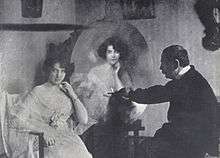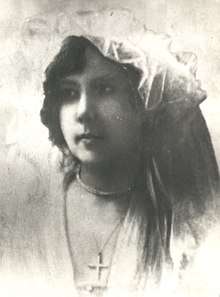Nair de Tefé
Nair de Teffé von Hoonholtz, mostly known as Nair de Teffé, (10 June 1886 – 10 June 1981) was Brazil's first female cartoonist, as well as a painter, singer and pianist.
Nair de Teffé | |
|---|---|
 Nair de Teffé being painted by Guirand de Scevola | |
| First Lady of Brazil | |
| In office 8 December 1913 – 15 November 1914 | |
| President | Marshal Hermes da Fonseca |
| Preceded by | Orsina Francioni da Fonseca |
| Succeeded by | Maria Carneiro Pereira Gomes |
| Personal details | |
| Born | 10 June 1886 Petrópolis, Rio de Janeiro, Empire of Brazil |
| Died | 10 June 1981 (aged 95) Rio de Janeiro, Rio de Janeiro, Brazil |
| Spouse(s) | Marshal Hermes da Fonseca |
| Occupation | Cartoonist, painter, singer |
Afterwards, she changed her name to Nair de Teffé Hermes da Fonseca.
Biography
Born in Petrópolis, Nair de Teffé was the daughter of Admiral Antônio Luís von Hoonholtz, Baron of Teffé, and granddaughter of Prussian military and aristocrat Friedrich Wilhelm von Hoonholtz, that moved to the Empire of Brazil. As a girl, she studied in Paris and Nice. In 1909, she published her first work in Fon-Fon magazine, under the pseudonym of Rian ("Nair" backwards). Her caricatures were also published in, among others, the magazines O Binóculo, A Careta, O Malho, as well as the newspapers Gazeta de Notícias and Gazeta de Petrópolis. She had an agile hand which transmitted people's characters quite well.
She stopped working as a cartoonist in 1913 when she married the then Brazilian President, Marshal Hermes da Fonseca.

Nair de Teffé was a woman ahead of her time. As First Lady she hosted soirées in Catete Palace which became famous for introducing the guitar in society salons. In 1914, Nair de Teffé organized a recital to launch Corta Jaca, a maxixe composed by Chiquinha Gonzaga. The following day, controversy and criticism developed because the presidential palace had promoted and disseminated music that had its roots in what the social elite believed were lascivious and vulgar dances. Bringing popular music to the presidential palace was considered at the time to be a breach of protocol, causing controversy in the highest ranks of Brazilian society and politics. Ruy Barbosa had strong criticism about the wife of the president.
After the presidential mandate ended, she moved to Europe. In 1921 she returned to Brazil and in 1922, participated of the Modern Art Week. Began to participate in Brazilian Academies(organizations) of art and in 1932 she founded a theater, Cinema Rian, which had a privileged locate (facing the sea of Copacabana: Photo of the theater Cinema Rian). Afterwards, Nair started playing at casinos and lost a great part of her fortune, as well as an island in the coastline of Angra dos Reis.
In 1959, at the age of 73, Nair de Tefé resumed making caricatures. In the late 1970s, she still participated in commemorations of International Women's Day. She died in Rio de Janeiro on her 95th birthday.
References
- (in Portuguese) Rodrigues, Antonio Edmilson Martins. Nair de Teffé: vidas cruzadas. Rio de Janeiro: Editora FGV, 2002. ISBN 85-225-0389-3